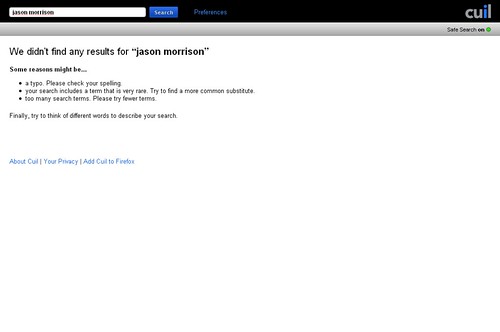Reid posted a review already, but I thought I’d add my two cents about this new search engine, Cuil.
First off, it’s great to see more companies making a serious go at web search. I don’t speak for my employer (standard disclaimers apply), but I personally am always happy to see new attempts at information retrieval on the web. More competition can only make things better for users. Heck, I’ve even cooked up a bit of a search system based on my research into IR with tagging systems and folksonomies myself, though it’s too much of a toy to release to the public.
Second, it’s a bit underwhelming to see a ton of press coverage of a new search engine, load up the site and do a simple vanity search, only to see this:
I know I’m not exactly the most famous person in the world, but I do have a website. Really this is just the result of scaling problems – too many people hitting this brand new service at the same time. I can’t complain too much since if I ever released my little search system, it would fail at 4 concurrent users or so. But I also don’t think I could get the amount of press that they’ve managed to get either.
Third point, I don’t know much about their architecture and algorithms but from the about us page I thought this was kind of interesting:
The Internet has grown exponentially in the last fifteen years but search engines have not kept up—until now. Cuil searches more pages on the Web than anyone else—three times as many as Google and ten times as many as Microsoft.
Do they really think the main problem of web search is too few items in the index?
If you want to read more, Read/Write Web has a good review.
